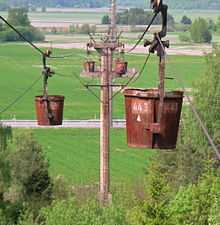Ropeway conveyor

A ropeway conveyor or material ropeway[1] is essentially a subtype of gondola lift, from which containers for goods rather than passenger cars are suspended.
Ropeway conveyors are typically found around large mining concerns, and can be of considerable length. The COMILOG Cableway, which ran from Moanda in Gabon to Mbinda in the Republic of the Congo, was over 75 km in length. The Norsjö aerial tramway in Sweden had a length of 96 kilometers.
The world's first cable car on multiple supports was built by Adam Wybe in Gdańsk, Poland in 1644.
In Ethiopia the Italians built the Asmara-Massawa Cableway in 1936, which was 75 km long.
Conveyors can be powered by a wide variety of forms of energy, electric, engines, or gravity (particularly in mountainous mining concerns, or where running water is available).[2]
In Popular Culture
The plot of the novel Zorba the Greek by Nikos Kazanzakis is framed by the construction of a ropeway conveyor by the titular character.
See also
References
- ↑ Ernst, Dr.-Ing. Richard (1989). Wörterbuch der Industriellen Technik (5th ed.). Wiesbaden: Oscar Brandstetter, 1989, p. 659. ISBN 3-87097-145-2.
- ↑
External links
- La Teleferica Massaua-Asmara (pictures of Ethiopian Ropeway) www.trainweb.org
- Conveyor & Ropeways Services Pvt. Ltd. www.crspl.com
- Low-tech Magazine: "Aerial ropeways: automatic cargo transport for a bargain"
| |||||||||||||||||||||||||||